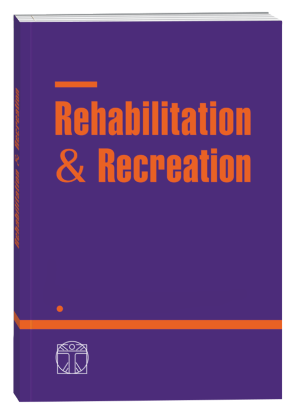DIFFERENTIATED USE OF PHYSICAL EXERCISES IN PHYSICAL EDUCATION CLASSES WITH STUDENTS WITH DIFFERENT LEVELS OF PHYSICAL READINESS
DOI:
https://doi.org/10.32782/2522-1795.2022.12.17Keywords:
students; physical readiness; physical exercises; differentiation; motor actionsAbstract
The urgency of the problem presented in the article is the need to modernize the traditional process of physical education of students, the introduction of new approaches and technologies. The article intends to partially fill the gap in the system of theoretical and methodological support of differentiated doing physical exercises by students with different levels of physical readiness. The study used methods of literature analysis, monitoring the process of physical education in higher education, pedagogical modeling. Attention is focusing on the use of elements of health-improving fitness in physical education classes with a wide variety of motor actions, load on all muscle groups and their development. The variety of means of fitness promotes the introduction of a differentiated approach to the process of physical education of student youth. Among its physical individual criteria, the most important is the level of physical condition, which takes into account the complex of signs that characterize the morphofunctional state of the organism, the level of development of physical qualities and abilities required for the vital activity of the organism. Physical condition includes anthropological, motor and physiological components and determined by physical development, physical capacity, physical readiness, health, and functional capabilities of the body. The presented article considers the differentiation of physical exercises according to the criterion of the level of students' physical readiness. Differentiation groups can be formed according to the level of development or lag in the development of certain physical qualities, while low, average and high levels of physical readiness distinguished by different methods. A differentiated approach involves taking into account not only the volume and intensity of the load, but also the content, nature and complexity of physical exercises and some their elements. The exercises of the complexes, intended for students with low level of physical readiness, and students with average and high level of physical readiness, differ primarily in the nature and complexity of motor actions. The article considers possible motor actions that make up the content of exercises with imitation of walking in place, exercises for the development of the muscles of the arms and shoulder girdle, trunk, abdominal press, legs, designed to be performed in groups of students with low level of physical readiness, and students with average and high level of physical readiness. A conclusion was made about the expediency of applying a differentiated approach to the development of sets of exercises to be performed in physical education classes with students with different levels of physical readiness, taking into account the nature and complexity of motor actions.
References
Алькова С. Ю. Реализация дифференцированного подхода в физическом воспитании на основе субъектного опыта студентов. Теория и практика физической культуры. 2003. № 4. С. 10-12.
Барсукова Т. О., Антіпова Ж. І. Оздоровчий фітнес як інноваційний засіб фізичного виховання у закладах вищої освіти. Global and Regional Aspects of Sustainable Development: Scientific Collection «InterConf», No. 54: with the Proceedings of the 3th International Scientific and Practical Conference (May 4-5, 2021). Copenhagen, Denmark: Berlitz Forlag, 2021. 606 p. P. 590-595.
Беляк Ю. І., Грибовська І. Б., Музика Ф. В., Іваночко В. В., Чеховська Л. Я. Теоретико-методичні основи оздоровчого фітнесу: навч. посібник. Львів: ЛДУФК, 2018. 208 с.
Бондарчук Н. Я. Характеристика спектру критеріїв диференціації у фізичному вихованні різних категорій населення. Спортивний вісник Придніпров'я. Дніпропетровськ, 2012. № 1. С. 53-58.
Бондарчук Н. Я., Чернов В. Д. Чинники диференційованого підходу та критерії диференціації у фізичному вихованні різних категорій населення. Фізична культура, спорт та здоров'я нації; зб. наук. праць. Вип. 1. Т. 1. Вінниця, 2011. С. 236-241.
Кулик Н. А. Фітнес в системі оздоровчої фізичної культури студентів ВНЗ. Актуальні проблеми фізичного виховання різних верств населення: зб. наук. статей ІІІ Всеукраїнської наук.-практ. конференції. Харків, 2017. С. 105-110.
Лавриненко Д. И. и др. Разработка дифференцированной системы физической подготовки студентов. Физическое воспитание студентов творческих специальностей: сб. науч. трудов. Харьков: ХГАДИ (ХХПЧ), 2003. № 1. С. 81-90.
Маляр Н. С., Маляр Е. І. Оздоровчий фітнес: Методичні рекомендації. Тернопіль: Економічна думка, 2019. 41 с.
Петрица П. М. Фізична підготовленість студентів та шляхи її поліпшення. Спортивна наука України. 2018. № 6 (88). С. 39-44.
Товкун Л. П. Фізична підготовленість студентів до занять фізичними вправами: сучасний стан проблеми. Молодий вчений. 2016. № 9.1 (36.1). С. 157-160.
Downloads
Published
How to Cite
Issue
Section
License

This work is licensed under a Creative Commons Attribution-NonCommercial-NoDerivatives 4.0 International License.











